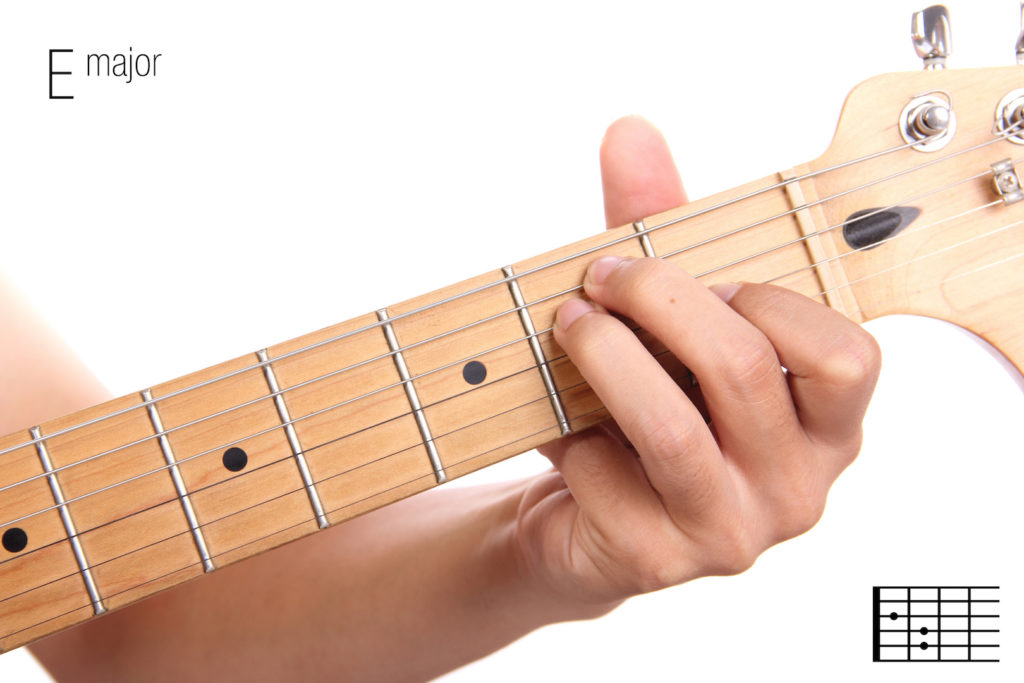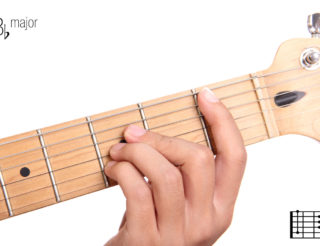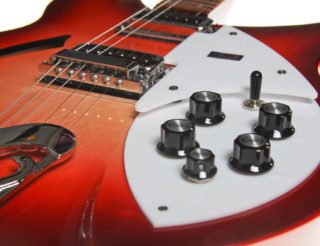E Chord on Guitar (easy): History, Chord Shapes, Major Scale & Songs in the Key of E
Author: Wanda Waterman

Welcome to another article in our “Chord of the Week” series, in which we share a new guitar chord every week, exploring its history, its relevance, how it’s played on the guitar, its major scale, some common chord progressions, and a few popular songs in the chord’s key!
This week we’re bringing you the E Major chord, the root chord of the key of E. In case you missed our earlier posts, check out C-Chord & D-Chord.
Table of Contents
E Major History Lesson: One Butch Chord
 Throughout the history of serious classical music, E Major has been a fairly uncommon key. When you do find it, it’s often as a drama-heightening switch from another key like D minor or E Minor. Bruckner, Haydn, Rachmaninioff, Tchaikovsky, Brahms, Mendelsohn and Vivaldi each produced one-off works in E.
Throughout the history of serious classical music, E Major has been a fairly uncommon key. When you do find it, it’s often as a drama-heightening switch from another key like D minor or E Minor. Bruckner, Haydn, Rachmaninioff, Tchaikovsky, Brahms, Mendelsohn and Vivaldi each produced one-off works in E.
In the Palace of Westminster in London England the bells are tuned to the key of E Major, so the melody of the famous chimes that sound every quarter hour (“the Westminster chimes”) contain the notes E, F-sharp, G-sharp, and B.
The rarity of its occurrence in classical pieces may be due to its difficulty for wind instruments. E Major is a little easier for stringed instruments, but by far the instrument that E Major loves best is the guitar.
Vitamin E— For Virility, Fertility, and Good Times
Once you start playing the E chord and a few progressions in the key of E Major, you can’t help but feel the power!
There’s a darn good reason why the key of E is so popular with blues and rock— it’s practically bursting with testosterone! Listen to B.B.King’s “Marry You” and you’ll know exactly what we mean.
The E Chord Position on the Guitar
The key of E Major, and especially its root chord, E, have a slightly gritty, grinding quality that might even be described as sexy, making it the perfect vehicle for lyrics dealing with the themes we find so often in blues songs: sexual rejection, powerful physical desires, and vengeance.
E Major is at the same time a triumphant key, one that joyfully proclaims success, conquest, and the joy of life, but in a manner more earthy and sensual than that of the key of D Major (discussed last week).
If a blues song isn’t written in the key of E Major you can always get it to sound “bluesier” by switching keys. The chord positions of this key also make bending strings, hammer-ons and hammer-offs, a breeze.
How to Play the E Chord Position on Your Guitar
!function(e,r,d){var t,c=e.getElementsByTagName(r)[0];e.getElementById(d)||(t=e.createElement(r),t.id=d,t.src=”https://uberchord-backend.firebaseapp.com/uberchord-embed-sdk.js”,c.parentNode.insertBefore(t,c))}(document,”script”,”uberchord-jssdk”);
The E Major chord is fairly simple to play, requiring only three fingers, and all the other strings can be played open. Like the basic D Major chord position, the E Major chord position is a great “base camp” for your fingers, granting you easy access to grace notes and multiple interesting and sublime variations. Playing it in the position shown above grants maximum finger freedom.
Theory and Practice: The Pattern of the E Major Scale Explained
If you already know a bit of music theory (if you don’t, here’s a great place to start) you’ll know that the sequence of tones in a major key are as follows:
whole tone, whole tone, half tone, whole tone, whole tone, whole tone, half-tone
That is, at the third and the seventh places in the scale there’s a half tone, and between all the other notes there are whole tones.
 The scale of the key of E is made up of the notes E, F#, G#, A, B, C#, D#, and E. Below is the E scale in standard musical notation, with E at its root and another E, an octave higher, at its summit.
The scale of the key of E is made up of the notes E, F#, G#, A, B, C#, D#, and E. Below is the E scale in standard musical notation, with E at its root and another E, an octave higher, at its summit.
Here’s how it looks played on the guitar: 
The E Major chord, which forms the root of this scale, is made up of the notes E, G#, and B— the first, third, and fifth notes of the key of E.
On the guitar, using the basic E Major chord position, these notes arrive in this order: E, B, E, G#, B, E.
If all this is sounding a little complicated, don’t worry— the Uberchord blog has a great series of music theory articles to lead you to clarity one step at a time. Knowing the theory behind guitar playing will help you to be a better musician and give you the peace of mind that comes with knowing exactly what you’re doing and how it all fits together. Learning music theory on the side is a wonderful complement to using the free Uberchord app!
Common Chord Progressions in the Key of E
!function(e,r,d){var t,c=e.getElementsByTagName(r)[0];e.getElementById(d)||(t=e.createElement(r),t.id=d,t.src=”https://uberchord-backend.firebaseapp.com/uberchord-embed-sdk.js”,c.parentNode.insertBefore(t,c))}(document,”script”,”uberchord-jssdk”);
(From “Give Me One Reason,” by Tracy Chapman)
If you were to use every chord in the key of E Major, these would be the chords you would use. You won’t always be using chords in the same key as the one you’re playing in, but it helps to know what they are:
E major, F# minor, G# minor, A major, B major, C# minor, and D# diminished
Why are the second, third and the sixth chords minor? Because in the major scale the chords at the second, third, and sixth positions of the key are minor. Accept it.
Why is the D# a diminished chord? Same reason.
Why is the B sometimes played as a B7? Because it sits in the fifth position of the key of E, giving it the honour of being the chord that announces that a musical phrase is about to end. (Play some of the chord progressions below and you’ll see what we mean.)
Adding the seventh note of the key of B (A) to the B chord makes the B chord sound a little more topheavy, as if it’s about to fall over onto the root chord (E) that follows it, or, in cases where no chord comes next, giving the musical phrase an unfinished, “leaving them hanging” kind of sound.
(If you want to go more deeply into chord progressions and the musical ideas they communicate, check out this article series on chord progressions.)
Once you’ve completed your Uberchord App (click for free download) lessons you can fool around with the following progressions to get a feel for how the chords create a sense of beginning, development, and ending depending on their context.
Most of the songs you hear are made up of combinations of these and other chord progressions. As you play them and get used to their sound, you’ll hopefully realise that you’ve heard them before in many different forms and contexts.
- E, A, B, E
- E– B – C# minor – A
- E – C# minor – A – B
- E– B – C# minor – G# minor – A –E – A – B
- Blues: E –E –E –E – A – A – E–E – B – B –E –E
- F# minor – A – B
- E– A – B – A
- B – A – E
- C# minor – A – E– B
- C# minor – B – C# minor – B
Just A Few Great Songs in the Key of E Major
As we’ve already mentioned, the more you play, the more you’ll notice that each key has its own peculiar emotional character.
Because the key of E is so full of oomph and gusto it’s the perfect key for expressing powerful desires, triumphant sentiments, and self-confidence.
It can be Landy Antebellum’s “Need You Now”
It can be Red Hot Chilli Pepper’s “Uber the Bridge”
It can be tragically romantic, like John Mayer’s “Slow Dancing in a Burning Room.”
It can be a transcendent declaration of joy in the face of loss, like Celine Dion’s “My Heart Will Go on.”
Spend a little time with the key of E today. You may just need a cold shower afterwards. We also recommend you look into other articles on our website like pretty guitar chords, the C# minor scale guitar, and little saint nick chords.
References:
Cosmic Music: Musical Keys to the Interpretation of Reality, essays by Marius Schneider, Rudolf Haase, and Hans Erhard Lauer
This is Your Brain on Music: The Science of a Human Obsession, by Daniel J. Levitin
Characteristics of Musical Keys
A History of Key Characteristics in the Eighteenth and Early Nineteenth Centuries, by Rita Steblin
The 10 Most Used Chord Progressions in Pop and Rock and Roll








I really like your writing style, superb info , thankyou for posting : D.